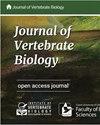No Evidence of Pre-Hibernation or Pre-Migratory Body Mass Gain in Miniopterus natalensis in North-Eastern South Africa
IF 1.5
4区 生物学
Q2 ZOOLOGY
引用次数: 2
Abstract
Abstract. Migration and hibernation are survival strategies that require physiological preparation using fattening. Bats employ both strategies in times of resource shortages. However, because males and females vary seasonally in their reproductive physiological needs, they may employ different fattening patterns. Whilst fattening, migration and hibernation are common in temperate bats, little is known about subtropical migratory insectivores. This study investigated seasonal variation in body mass of the regionally migrating Natal long-fingered bat Miniopterus natalensis to determine if males and females show fattening in preparation for migration/hibernation. Seasonal change best explained the variation observed in overall body mass, whilst sex and forearm length explained the variation to a lesser extent. Body mass between males and females differed significantly by reproductive category among the four seasons. Forearm length was a significant predictor of the body mass of males. Scrotal males had a higher body mass in summer compared to autumn. This pattern of mass gain was not observed in non-scrotal males. The summer body mass of nonpregnant and post-lactating females was not significantly higher than the autumn body mass of nonpregnant females, which did not support the hypothesis that females would exhibit fattening during summer before migration. Results suggest that males and females employ different mass-gain strategies related to reproductive investment rather than fattening preparation for migration or hibernation.南非东北部纳塔利小翅猴冬眠前或迁徙前体重增加的证据
摘要迁徙和冬眠是需要通过增肥进行生理准备的生存策略。蝙蝠在资源短缺的时候同时使用这两种策略。然而,由于雄性和雌性的生殖生理需求随季节变化,它们可能会采用不同的育肥模式。虽然增肥、迁徙和冬眠在温带蝙蝠中很常见,但人们对亚热带迁徙食虫动物知之甚少。这项研究调查了区域迁徙的纳塔尔长指蝙蝠纳塔尔蝙蝠(Miniopterus natalensis)身体质量的季节变化,以确定雄性和雌性是否在为迁徙/冬眠做准备时出现增肥现象。季节性变化最好地解释了整体体重的变化,而性别和前臂长度在较小程度上解释了这种变化。在四季中,雄性和雌性的体重在生殖类别上存在显著差异。前臂长度是男性体重的重要预测指标。与秋季相比,阴囊雄性在夏季的体重更高。在非阴囊男性中没有观察到这种质量增加的模式。未怀孕和哺乳后雌性的夏季体重并不显著高于未怀孕雌性的秋季体重,这不支持雌性在迁徙前的夏季会出现增肥的假设。结果表明,雄性和雌性采用了不同的与生殖投资有关的群体增重策略,而不是为迁徙或冬眠做增肥准备。
本文章由计算机程序翻译,如有差异,请以英文原文为准。
求助全文
约1分钟内获得全文
求助全文

 求助内容:
求助内容: 应助结果提醒方式:
应助结果提醒方式:


